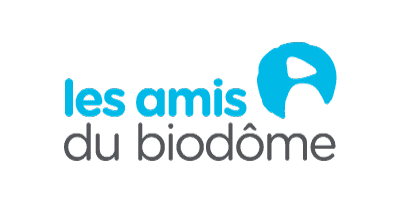The Biodome ecosystems are representation of nature. Among the advantages, we control the temperature, the wind is almost non-existent and it rains according to our needs (rain is simulated by watering plants run by horticulturists). To stimulate the natural needs of animals, the animal care team must actively re-create winter. One way is to retrieve snow from outside for distribution in the animal habitats of the Laurentian Maple Forest. A work much appreciated by the River otter!
SABM is proud to support the expansion of the SEM’AIL jr. program until August 2015 thus expanding the network of partners in the region and to increase the number of youth involved in the preservation of wild garlic. – a vulnerable star species in Quebec conservation.
In spring 2010, the Biodome developed a new educational program: SEM’AIL jr. The secret mission of our F.B. Ail squad agents: get actively involved in the conservation of biodiversity, creating a new viable population of wild garlic in their region.
A positive experience of nature at an early age is an effective way to build a commitment to the environment.
In 1999 The Montreal Biodome first developed SEM’AIL, an awareness program catering to wild garlic. From 2000 to 2004, nearly a million seeds were distributed to 1,117 maple sugar bush owners interested in planting the species for preservation. Also, the participants replanted more than 440,000 bulbs from illegal harvesting. It is estimated that this program has led to the creation of over 500 new colonies of wild garlic in the regions most affected by the over-harvesting: Montérégie , Lanaudière, Laurentians , Ottawa river region and the Eastern Townships. Despite all these efforts, the species is still widely picked and wildlife officers seize average 80,000 bulbs per year!
L’ail des bois (Allium tricoccum) est une petite plante printanière typique de nos érablières. Ses bulbes sont comestibles et très recherchés par les amateurs. En 1995, elle devenait la première espèce légalement désignée au Québec. La vente est désormais interdite et la cueillette à des fins personnelles est limitée à 50 bulbes par an. Bien connue du public, la voilà devenue une espèce emblématique de la conservation au Québec.
SEM’AIL jr. is a school component that has raised enthusiasm in children since 2010. Thirteen schools in the most affected regions by the decline have already accepted the challenge to create a new viable colony of wild garlic in their community.
- A youth training class started in April, with a workshop led by a Biodome facilitator.
- A month later, the whole class went to the forest to perform planting. Each student sowed 100 seeds, for a total of 2,500-3,000 seeds per class.
- These young people, mostly in grade four, will have a chance to pursue their ‘top secret ‘ mission the following spring, going out to count emerged seedlings and transplanted bulbs.
For the SABM, this project constitutes concrete involvement in the restoration of biodiversity.
Rockhopper Penguin
A Rockhopper Penguin born on October 13 is about to make its debut in the great basin. Fed by its parents until the age of 40 days, the chick was then isolated from the colony. This practice is intended to initiate hand feeding by aquarists from polar section. It is also at this time that begins the biomedical workouts that are essential to rigorous health monitoring. Now aged 80 days his weight has reached 2.25 Kilograms. He will join the colony in January and you can recognize him by the green and gold ring he wears on the right wing.
Seek the help of an animator to help you find him…
Canada Lynx
The Biodôme is a place where we try to recreate nature. To ensure a stimulating environment, the animal attendants of the Laurentian Maple Forest will add to snow in animal habitats. And, when conditions permit, you can see among others the lynx and otters running, jumping and even sliding in the snow. On December 18, the newspaper Le Devoir was present. Read the article…
Turquoise tanager
Since few weeks, the birds community is larger. A couple of Turquoise Tanager (tangara mexicana) have breed successfully. The brood of two chicks is now about to be completely fledged. The immatures (yet unknown sex) are extremely mobile and travel extensively, almost everywhere in the Tropical forest of the Biodôme. It is still possible to see the parents feed the young but to do so you’ll have to look very high in the trees… and long enough to give a stiff neck !
Ask one of our staff to help you find them.
Northern Helmeted Curassow.
Our Curassow had a narrow escape. A few weeks ago one of our animal custodians noticed that the Curassow was not moving as usual. He seemed to have mobility problems and lost his balance frequently. Following a battery of tests, the Biodôme veterinary team discovered a metal object in the digestive system of the bird; evidently, it should not be there. The bird was suffering from zinc poisoning due to the foreign body. It took an intervention with specialists from the veterinary hospital of St-Hyacinthe to remove what was confirmed to be a penny. This coin was probably swallowed out of curiosity and was slowly dissolved by the digestive enzymes of the Curassow thus releasing a dose of zinc sufficient to cause neurological problems in birds. Fortunately we were able to react in time and following treatment to neutralize the effect of the metal coin, the Curassow could regain his health.
He is now back in the tropical ecosystem.

Upcoming Member Activities
-
 The Friends Spring Cleaning
Date to be confirmed
The Friends Spring Cleaning
Date to be confirmed
-
 A Night at the Biodôme
9 May 2025
A Night at the Biodôme
9 May 2025
-
 Research at the Biodôme
25 May 2025
Research at the Biodôme
25 May 2025
News From the SABM
-

Adopt a Tree Square!
Apr 12th 2:01pm -

Cans for Corridors
Oct 20th 11:55am -

Welcome to our new administrators!
Sep 29th 10:21am
Hours
Heures
Du mardi au dimanche – 9h-17h
Our Address
The Friends of the Biodôme
4777, avenue Pierre-de Coubertin
Montreal (Quebec) H1V 1B3
Tel : 514 868-3098






